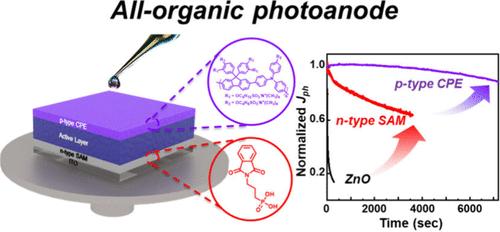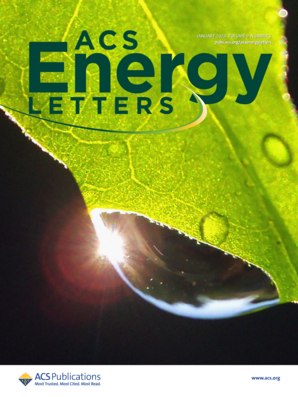Realization of All-Organic Photoanodes for Photoelectrochemical Cells
IF 19.3
1区 材料科学
Q1 CHEMISTRY, PHYSICAL
引用次数: 0
Abstract
Organic photoelectrochemical (OPEC) cells are efficient at generating photocurrents but face significant challenges in long-term stability due to the incompatibility of metal oxide charge transport layers with organic photoactive materials and their pH sensitivity. To overcome these issues, we developed an all-organic photoanode incorporating n-type self-assembled monolayers (SAMs) with imide core modifications, which optimize the work function of the ITO substrate, improving charge transfer and the onset potential (Vonset). The addition of a hole-transporting p-type conjugated polyelectrolyte (TPAFS-7TMA) further enhances hole transport and water wettability. This photoanode, designed for ascorbic acid oxidation, achieved a Vonset of 0.25 VRHE and a photocurrent density (Jph) of 7.92 mA cm–2 at oxidation potential and retained 90% of its initial Jph over 2 h under 1 sun irradiation. This all-organic design effectively addresses the limitations of conventional OPEC cells, providing a stable and efficient alternative for durable OPEC systems. We developed a stable and efficient all-organic photoanode for OPEC cells, utilizing imide-modified n-type SAMs and a p-type conjugated polyelectrolyte to enhance charge transfer, water wettability, and durability, achieving significant performance improvements.

求助全文
约1分钟内获得全文
求助全文
来源期刊

ACS Energy Letters
Energy-Renewable Energy, Sustainability and the Environment
CiteScore
31.20
自引率
5.00%
发文量
469
审稿时长
1 months
期刊介绍:
ACS Energy Letters is a monthly journal that publishes papers reporting new scientific advances in energy research. The journal focuses on topics that are of interest to scientists working in the fundamental and applied sciences. Rapid publication is a central criterion for acceptance, and the journal is known for its quick publication times, with an average of 4-6 weeks from submission to web publication in As Soon As Publishable format.
ACS Energy Letters is ranked as the number one journal in the Web of Science Electrochemistry category. It also ranks within the top 10 journals for Physical Chemistry, Energy & Fuels, and Nanoscience & Nanotechnology.
The journal offers several types of articles, including Letters, Energy Express, Perspectives, Reviews, Editorials, Viewpoints and Energy Focus. Additionally, authors have the option to submit videos that summarize or support the information presented in a Perspective or Review article, which can be highlighted on the journal's website. ACS Energy Letters is abstracted and indexed in Chemical Abstracts Service/SciFinder, EBSCO-summon, PubMed, Web of Science, Scopus and Portico.
 求助内容:
求助内容: 应助结果提醒方式:
应助结果提醒方式:


